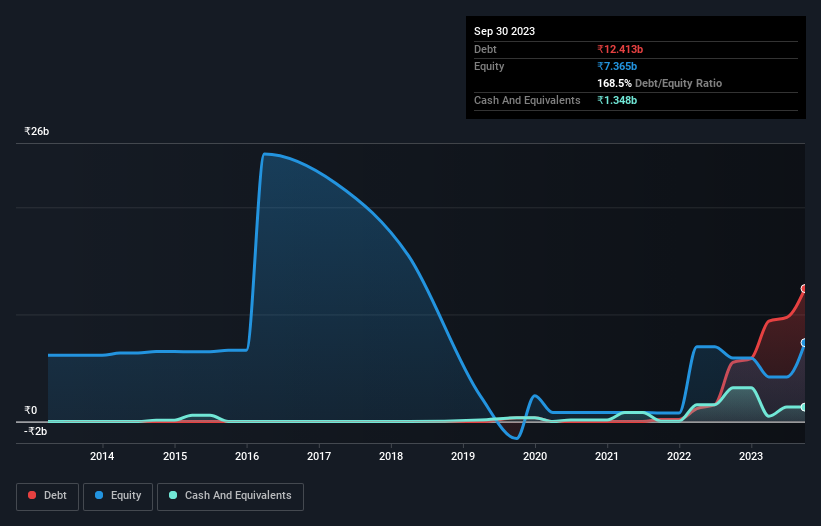- India
- /
- General Merchandise and Department Stores
- /
- NSEI:RTNINDIA
Is RattanIndia Enterprises (NSE:RTNINDIA) Using Too Much Debt?

David Iben put it well when he said, 'Volatility is not a risk we care about. What we care about is avoiding the permanent loss of capital.' So it seems the smart money knows that debt - which is usually involved in bankruptcies - is a very important factor, when you assess how risky a company is. We can see that RattanIndia Enterprises Limited (NSE:RTNINDIA) does use debt in its business. But the more important question is: how much risk is that debt creating?
Why Does Debt Bring Risk?
Debt is a tool to help businesses grow, but if a business is incapable of paying off its lenders, then it exists at their mercy. Part and parcel of capitalism is the process of 'creative destruction' where failed businesses are mercilessly liquidated by their bankers. However, a more frequent (but still costly) occurrence is where a company must issue shares at bargain-basement prices, permanently diluting shareholders, just to shore up its balance sheet. Of course, the upside of debt is that it often represents cheap capital, especially when it replaces dilution in a company with the ability to reinvest at high rates of return. The first step when considering a company's debt levels is to consider its cash and debt together.
View our latest analysis for RattanIndia Enterprises
What Is RattanIndia Enterprises's Debt?
You can click the graphic below for the historical numbers, but it shows that as of September 2023 RattanIndia Enterprises had ₹12.4b of debt, an increase on ₹5.52b, over one year. However, it does have ₹1.35b in cash offsetting this, leading to net debt of about ₹11.1b.

A Look At RattanIndia Enterprises' Liabilities
The latest balance sheet data shows that RattanIndia Enterprises had liabilities of ₹22.5b due within a year, and liabilities of ₹438.6m falling due after that. Offsetting this, it had ₹1.35b in cash and ₹556.0m in receivables that were due within 12 months. So it has liabilities totalling ₹21.0b more than its cash and near-term receivables, combined.
Given RattanIndia Enterprises has a market capitalization of ₹110.2b, it's hard to believe these liabilities pose much threat. Having said that, it's clear that we should continue to monitor its balance sheet, lest it change for the worse.
In order to size up a company's debt relative to its earnings, we calculate its net debt divided by its earnings before interest, tax, depreciation, and amortization (EBITDA) and its earnings before interest and tax (EBIT) divided by its interest expense (its interest cover). The advantage of this approach is that we take into account both the absolute quantum of debt (with net debt to EBITDA) and the actual interest expenses associated with that debt (with its interest cover ratio).
Weak interest cover of 1.6 times and a disturbingly high net debt to EBITDA ratio of 7.7 hit our confidence in RattanIndia Enterprises like a one-two punch to the gut. This means we'd consider it to have a heavy debt load. However, it should be some comfort for shareholders to recall that RattanIndia Enterprises actually grew its EBIT by a hefty 2,440%, over the last 12 months. If that earnings trend continues it will make its debt load much more manageable in the future. When analysing debt levels, the balance sheet is the obvious place to start. But ultimately the future profitability of the business will decide if RattanIndia Enterprises can strengthen its balance sheet over time. So if you want to see what the professionals think, you might find this free report on analyst profit forecasts to be interesting.
But our final consideration is also important, because a company cannot pay debt with paper profits; it needs cold hard cash. So we clearly need to look at whether that EBIT is leading to corresponding free cash flow. Over the last two years, RattanIndia Enterprises saw substantial negative free cash flow, in total. While that may be a result of expenditure for growth, it does make the debt far more risky.
Our View
Neither RattanIndia Enterprises's ability to convert EBIT to free cash flow nor its net debt to EBITDA gave us confidence in its ability to take on more debt. But its EBIT growth rate tells a very different story, and suggests some resilience. Taking the abovementioned factors together we do think RattanIndia Enterprises's debt poses some risks to the business. So while that leverage does boost returns on equity, we wouldn't really want to see it increase from here. There's no doubt that we learn most about debt from the balance sheet. But ultimately, every company can contain risks that exist outside of the balance sheet. To that end, you should learn about the 4 warning signs we've spotted with RattanIndia Enterprises (including 2 which can't be ignored) .
At the end of the day, it's often better to focus on companies that are free from net debt. You can access our special list of such companies (all with a track record of profit growth). It's free.
New: AI Stock Screener & Alerts
Our new AI Stock Screener scans the market every day to uncover opportunities.
• Dividend Powerhouses (3%+ Yield)
• Undervalued Small Caps with Insider Buying
• High growth Tech and AI Companies
Or build your own from over 50 metrics.
Have feedback on this article? Concerned about the content? Get in touch with us directly. Alternatively, email editorial-team (at) simplywallst.com.
This article by Simply Wall St is general in nature. We provide commentary based on historical data and analyst forecasts only using an unbiased methodology and our articles are not intended to be financial advice. It does not constitute a recommendation to buy or sell any stock, and does not take account of your objectives, or your financial situation. We aim to bring you long-term focused analysis driven by fundamental data. Note that our analysis may not factor in the latest price-sensitive company announcements or qualitative material. Simply Wall St has no position in any stocks mentioned.
About NSEI:RTNINDIA
RattanIndia Enterprises
Engages in the manpower, human resource supply and consultancy, payroll management, technology, and other related services in India.
Slightly overvalued with questionable track record.
Market Insights
Community Narratives




